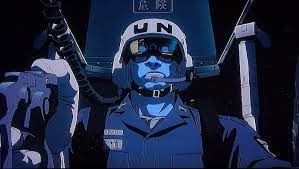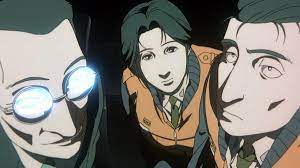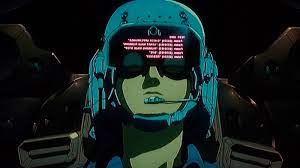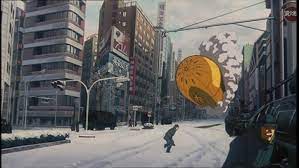Patlabor 2
January 14, 2024 · 0 comments
By Andrew Osmond.

The first Patlabor film is an excellent cerebral thriller. Patlabor 2 The Movie, though, is an artistic statement. Thirty years old, it’s still the anime that feels the most like live-action. It’s only tangentially a mecha film, with the title Patlabors on screen for a fraction of the running time. This is really a film about terrorism, and terror’s effects on a “developed” country, eight yearsbefore 9/11. Like Ghost in the Shell, it’s a conspiracy thriller with arthouse leanings. But it’s also memorable for a charged forbidden-love subplot, which adds so much to its beauty.
As in the first Patlabor film, Tokyo comes under an oblique threat, a mindgame. A bridge is destroyed by a missile that flies out of nowhere; a phantom plane causes panic in Tokyo’s airspace. The Patlabor characters are approached by a security insider, a comically sinister-looking agent called Arakawa, looking like a sneering vampire. He’s the film’s Deep Throat informant about what’s going on, and he wants the Patlabor team to investigate privately.
To be precise, Arakawa consults the team’s captains, Goto and Shinobu. Fans of Patlabor will be familiar with these two’s professional relationship, and the teases that it could go further. A year before Patlabor 2, there was a memorable video Patlabor episode (part of Patlabor: The New Files), in which Goto and Shinobu must spend the night together at a love hotel, though the story veered between tantalising and creepy. The pair’s portrait in Patlabor 2 is subtler. Early on, there’s a gem of a scene when Shinobu rages at Goto for going behind his back, with Goto looking hilariously childish as he tries to mollify her.
But this is a film about grown-ups. In 2002, Oshii said, “I find that I’m no longer much interested in female characters that are younger than thirty.” His comment also seems to apply to males. The film starts by cheekily misleading Patlabor fans. Following a pre-title prologue, we spend several minutes with the youngsters Noa and Shinohara, who usually take the leads in the Patlabor stories. But in Patlabor 2, they’re quickly relegated to bit-part duties, with only a few more scenes – and one of those scenes shows Noa resolving to be more grown up.

At the same time, the grown-ups can’t forget their youth. The big shock in the story is what it reveals about Captain Shinobu, who we’ve always respected for her coolheaded leadership. Now we learn that when she was younger, Shinobu was a star member of a Labor R&D team. There she had a forbidden relationship… with her married teacher, Tsuge, whom Arakawa claims is behind the Tokyo attacks.
While technically a subplot, this strand gives Patlabor 2 its beating heart. Oshii’s later Ghost in the Shell would have yearning frissons between Kusanagi and the Puppet Master, but Patlabor 2 serves up full-blooded film noir romance. As in Ghost, one of Patlabor 2’s most exquisite sequences takes place on a canal. Shinobu takes a boat through a snow-specked night, until she sees her quarry. Her expression remains impassive, but a train runs in the background behind her, its lighted windows opening her soul. Then Shinobu points a gun and shouts for Tsuge to stop, her voice ringing with desperation. It’s one of the most romantically charged cinema moments in anime.
It’s exquisite, but there are other rich sequences. One is a hushed, lyrical wordless interlude where tanks and soldiers are stationed in Tokyo to guard the city. Tokyo is defamiliarised; each shot becomes a study in incongruity because of the military’s inescapable presence in the frame. Yet we see daily urban life continue around this occupation. Finally there is soft-falling snow, anticipating the rain in Ghost.

The soldiers may be Japanese, but this sequence conjures memories of Japan’s occupation by American military from 1945 to 1952, and its legacy of the American army bases dotted around Japan. There was similar “Occupation” imagery in 1988’s Akira and 1969’s The Flying Ghost Ship; in the latter anime, massive tanks smash the cars of terrified civilians. But the situation in Patlabor 2 is framed as an object lesson to the audience. How would you respond to a “terror” crisis, and would your reactions only make the situation worse?
Oshii’s scenario is the grim antithesis of a film like Mamoru Hosoda’s 2009 Summer Wars. In Hosoda’s film, Japan is thrown into chaos when an A.I. programme wreaks havoc with the nation’s infrastructure – exactly the kind of situation Oshii loves. However, Hosoda has Japan being protected by a wise, elderly, influential matriarch with a samurai spirit, who marshals Japan’s leaders, old and young, to fight the enemy. In Patlabor 2, Tsuge’s attacks teach the reverse lesson. Japan’s leaders can only escalate the crisis, immersed in their power play and blinkered strategies.
Again, Shinobu is used to advance the film’s case. There’s a long scene where she browbeats her own all-male superiors in a conference room, and it’s terrific. It’s like the more openly sexy tongue-lash in Satoshi Kon’s Paprika, where the icy woman scientist Chiba lays into the geek genius Tokita: “Just indulge in your freakish masturbation!” Just moments after the browbeating, Shinobu is smacking black-suited men down in an elevator. By Oshii’s standards, it’s wondrously crowdpleasing.

But there’s one more important sequence in the film that’s very different, and arguably represents the real Oshii. It’s abstract, there’s a didactic monologue, and it takes the film far outside what we’d expect from a thriller. It involves Goto travelling to headquarters on a speedboat, travelling through Patlabor’s familiar setting of Tokyo Bay… although it’s an exceptionally bleak Bay, under an overcast, bruise-coloured sky. Goto doesn’t speak, but we hear a conversation he had earlier, with the vampiric Deep Throat agent, Arakawa.
This sequence is so far “outside” normal Patlabor that Goto isn’t even on screen for most of it. Instead we get slow panning shots of the Bay’s infrastructure, bleak and ostensibly ugly, but lifted to an austere beauty by the film’s artists. Atop that, there’s Kenji Kawai’s ambient soundtrack, softly lapping as in the “occupied Tokyo” sequence. Mostly we’re not hearing Goto in this sequence but Arakawa, a character that Patlabor fans don’t know from Adam, imposed on us without warning.
It’s hard not to think of Arakawa’s voice as Oshii’s own spoken commentary on the film. A decade earlier, in 1984 masterpiece Urusei Yatsura: Beautiful Dreamer, Oshii had included a deeply mysterious shot of a strange boy looking through a window at one of the lost characters. This boy never appears anywhere else in the film. Oshii later commented, “It’s an outsider looking in. Basically, it’s me, the director.” In Patlabor 2, Arakawa’s heavy voice is that of actor Naoto Takenaka. Ironically he’d go on to dub Samuel Jackson’s Nick Fury in the Marvel movies, embodying the military heroic fantasy that Patlabor 2 mocks.

In another interview, Oshii said, “With sequels like Beautiful Dreamer, Patlabor 2 and Innocence [Ghost in the Shell 2: Innocence], the only way I can take them on is to bring them into my own ‘field.’” Notably, all three Oshii films include prominent monologues that seemingly channel the director’s thoughts. It’s something that viewers may see as either an exasperating indulgence, or as an auteur breaking with commercial templates – Oshii studied Jean-Luc Godard, after all. His approach isn’t unique in anime, though; there were similar monologue devices in the rural scenes of Isao Takahata’s Only Yesterday, made two years before Patlabor 2.
Arakawa talks of Japan’s role in the modern world, acting as an unsinkable aircraft carrier for American aggression. Near the end of the film, it’s casually suggested that America is waiting for the chance to turn the clock back to 1945 and control Japan directly again. Despite being enemies, Arakawa and Tsuge clearly agree on these points, and Oshii too. In an email to Brian Ruh, author of Stray Dog of Anime: The Films of Mamoru Oshii, the director was unequivocal. “Tsuge is the other self of Mamoru Oshii. Tsuge’s political thoughts and opinions, if there are any, are all mine.”
Oshii had been an activist back in his high school days. Like many of his peers, he opposed the postwar relationship between Japan and America, where bogus rhetoric about “pacifism” hid Japan’s complicity in US aggression. In Patlabor 2, Arakawa and Goto talk about “unjust peace,” which Arakawa suggests is merely war redefined. While these arguments go back decades, and mirror the views of activists far beyond Japan, Patlabor 2 had a more recent real-world catalyst.
The film was made just as Japan’s Self-Defence Force – the country’s military force, ostensibly established for protective purposes – was operating overseas for the first time. In 1991, SDF minesweepers went to the Persian Gulf in the aftermath of the Gulf War. A year later, hundreds of SDF soldiers went to Cambodia for non-combat duties, such as repairing roads.

That’s referenced in Patlabor 2’s pre-title prologue, which shows SDF soldiers in UN helmets, operating military Patlabors “somewhere in south-east Asia.” The SDF soldiers are targeted by hostiles, but their command HQ forbids them from engaging, as that’s ruled as an offensive action by a defensive force. In the panic, most of the Japanese soldiers are killed. The rest of the film is framed as a response to this military sophistry, which put the soldiers in a lethal position.
Taken literally, the story in Patlabor 2 isn’t much more credible than a summer action blockbuster. Instead, this is a poetic, artful film – I haven’t even mentioned the plethora of bird imagery, which Oshii claimed had no symbolic meaning, but which is full of the spiritual yearning that would be fulfilled in Ghost in the Shell. And yet Patlabor 2 has a sobriety, a maturity and a contemporary grounding that make it feel extraordinarily like live-action – more than Perfect Blue, Grave of the Fireflies, Your Name or indeed Ghost in the Shell.
The film’s aesthetics help enormously. On the excellent Animétudes site, Matteo Watzky has an extensive article on Patlabor 2’s production. Compared to the first film’s designs, Watzky says, “Characters feel older, more mature and meditative… They are also far less ‘anime-like’… Noses and chins became much rounder, eyes smaller and the features of the face are generally heavier… I’d say that their most essential feature is their minimalism – the lack of details, but also of distinct expressions, which makes them particularly well-adapted to the mysterious, slow, mood of the movie…”
While there’d be a third Patlabor anime feature eight years later, it would be very different and would not involve Oshii. The director would revisit the film in 2015, in the live-action feature The Next Generation Patlabor – Tokyo War, which serves as both a remake and a sequel. There are also echoes of Patlabor 2 in an anime series by Oshii’s protégé Kenji Kamiyama, called Eden of the East. Made by Production I.G in 2009, it’s a comedy thriller, but it provocatively suggests many Japanese youngsters wish for a terror attack like the one in Patlabor 2.
Kamiyama told me, “In Eden, I wasn’t specifically inspired by Oshii, but after I made the series, there were people saying that it looked like my interpretation of some themes taken up by Oshii in Patlabor 2. So I realised there was probably something inside me, but it wasn’t a specific inspiration, I didn’t have it in mind.”
More recently still, Production I.G made Psycho-Pass: Sinners of the System, a trio of cinema films set in the SF world of Psycho-Pass, and directed by that franchise’s mainstay, Naoyoshi Shiotani. The middle Sinners film, “First Guardian” also has soldiers betrayed by their superiors, while there’s a shadowy antagonist who might be dead already, and an airborne attack on a Ministry of Defence building that openly homages a similar sequence in Patlabor 2… Except that the attack scene in the first film was far more bleakly beautiful.
Andrew Osmond is the author of 100 Animated Feature Films. Patlabor 2 is being released in the UK by Anime Limited.
Leave a Reply